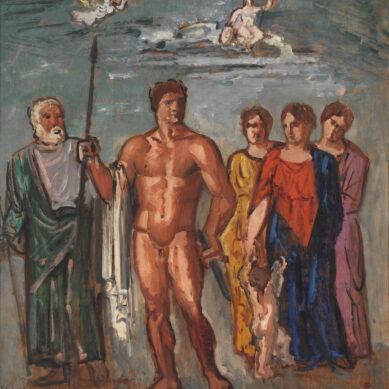You searched
Painter
Achille Funi
Are you interested in the sales or the purchase of his artworks?
We buy works of this artist
and of other painters and sculptors from the 16th century to the first half of the 20th century
The Berardi gallery offers a free and without obligation service for evaluation of ancient and modern art . To find your way in the art market, very complex and full of nuances, it is better to rely on a professional consultant who can answer fast and concretely to your needs. The clarity of the answers will resolve effectively the need to estimate or sell an asset.
Contact us immediately without commitment
Answers also in 24 hours:
Achille Funi
Achille Funi
Achille Funi attended the Dosso Dossi Municipal School of Art in Ferrara from the age of 12 to 15. In 1906, he moved to Milan to attend the Brera Academy of Fine Arts, where he trained under Cesare Tallone. He soon became involved with Carlo Carrà, Leonardo Dudreville and Antonio Sant’Elia.
Inevitably, he joined the Futurist group, but, as Boccioni also pointed out, he always managed to maintain a strong contact with reality through the volumetric presence of the figure. After exhibiting with the Futurist group Nuove Tendenze, he enlisted as a volunteer during the First World War.
He was one of the signatories of the manifesto Contro tutti i ritorni in pittura of 1920, still strongly linked to the Futurist concept of the exaltation of dynamism and modernity. But Achille Funi nevertheless maintained the firm plasticity that had always distinguished him, even in the simultaneous, rhythmic compositions of his Futurist works. Thus, it was already written that he would gradually distance himself from the Avant-garde in favour of a return to order based entirely on the evocation of Renaissance schemes.
Antonello Da Messina, Bellini and Raphael wisely entered Funi’s paintings, passing through the filter of the purist 19th century. In 1922 he met Margherita Sarfatti, who initiated his participation in the group Sette Pittori del Novecento (Seven painters of the 20th century), with whom he exhibited Terra e maternità at the Venice Biennale of the same year.
In 1923, with the other seven painters, he exhibited at the Pesaro Gallery and the following year, he sent L’architetto Chiattone, L’abbandonata, Giovinetta and Una persona e due età to the Biennale, all paintings characterised by a strong reference to classical art and solid, monumental bodies.
He exhibited with the Novecento Italiano in 1926 and 1929, becoming one of the most canonical interpreters of the return to order. The very delicate Venus in Love, together with eight other paintings, appeared at the 1928 Biennale, while at the 1930 Biennale he sent The Sibyl, Latin Venus, Melancholy and Portrait.
He was present at the first Roman Quadrennial in 1931 with paintings such as Ragazze alla finestra, Nudo, and Il foro romano, all of which were strongly linked to the Renaissance world: the compositions perfectly respected perspective, the black backgrounds containing mysterious portraits were reminiscent of Antonello da Messina and Piero della Francesca, but everything was reinterpreted in a profoundly modern key.
Funi’s first experiences as a muralist date back to these years, and in 1933 he and Sironi signed the Manifesto of Mural Painting. In the Sala della Consulta in Ferrara’s Palazzo Comunale in 1937, he painted the Mito di Ferrara (Myth of Ferrara), based on Ariosto: this powerful cycle revives the influence of Ferrara’s Renaissance painters such as Cosmè Tura and Ercole De Roberti. He then frescoed the Cristo Re in Rome and in 1945 he was awarded the chair of painting at the Accademia Carrara.
A major personal exhibition was held at the Galleria del Milione in Milan in 1937, where he exhibited eighty works, including cartoons for the frescoes in the church of San Francesco in Tripoli. At the Quadriennale in 1939, a personal room was dedicated to him in which he presented Figura femminile, Autoritratto, Mia madre, Mio padre and another vast series of cartoons for Tripoli.
In his later years, in addition to figure paintings and wall cycles, he devoted attention to landscape painting. He died in Appiano Gentile in 1972.
Elena Lago






